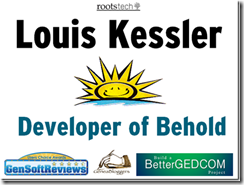Programming is like Songwriting - Sun, 11 Feb 2018
A programmer develops an original idea for a program and spends time writing it. Once you’ve got it working to some point, you put it online and test the waters. If it’s well taken, you go out on tour.
A songwriter develops some original ideas for some new songs and spends time putting the tracks together. Once the album is published and the tunes are liked to some point, they go out on tour.
One year’s the writing year. The next year’s the touring year.
I worked for many years until Version 1.0 of Behold was ready. I released it in 2011. It was time to test the waters.
In 2012, I entered Behold as a contestant in the 2012 RootsTech Developers Challenge and it was accepted. 2012 then saw me “on tour” as I attended the 3rd RootsTech in Salt Lake City, presenting Behold and meeting with other developers, genealogy bloggers and BetterGEDCOM folk as well as being on a panel discussing Sources where a few statements I said about source-based genealogy were to my surprise met with huge applause. Early 2013, I picked up my genealogy “tour” as a speaker on the 3rd Unlock the
in the 2012 RootsTech Developers Challenge and it was accepted. 2012 then saw me “on tour” as I attended the 3rd RootsTech in Salt Lake City, presenting Behold and meeting with other developers, genealogy bloggers and BetterGEDCOM folk as well as being on a panel discussing Sources where a few statements I said about source-based genealogy were to my surprise met with huge applause. Early 2013, I picked up my genealogy “tour” as a speaker on the 3rd Unlock the  Past genealogy cruise where I met my Australia genie friends for the first time.
Past genealogy cruise where I met my Australia genie friends for the first time.
During 2013, I continued work on Behold, and by the end of the year got it up to version 1.0.5.1.
2014 was another a touring year. It was back to my 2nd RootsTech where I was a speaker. In October, it was over the pond to Leiden, Netherlands where I spoke at the Gaenovium Conference organized by Tamura Jones.
During 2015, it was back to work, I finished and released Behold 1.2.
That was followed in 2016 by the 10th Unlock the Past Genealogy Cruise around New Zealand and Australia. It was there that Judy Russell coerced me into DNA analysis, so I took the leap and found that DNA now occupied and took over every spare moment left in my life. I needed something to analyze this mass of data, so I developed Double Match Triangulator for my own needs. When RootsTech later that year announced the Innovator’s Showdown for innovative genealogy products, I thought: “what the heck”, and submitted DMT, went to RootsTech 2017 and DMT took 3rd place.
Thus started the biggest “tour year” of my life, with me giving a workshop on DMT at the 37th IAJGS Conference in July in Orlando, with me giving DNA talks at the 2nd Great Canadian Genealogy Summit in October in Halifax, and then my attending the 13th Annual International Conference on Genetic Genealogy put on by Family Tree DNA in Houston in November.
My “songs” are different from everyone else. Programs are like music. You can either like my style or not. Everyone has their own taste as to what type of “music” they like and what soothes their soul. As a “writer”, I choose to “write” what I want to “listen” to. If others happen to like my “songs” as well, then that’s great. If not, I completely understand.
There are a lot of genealogy programs out there, as the almost 1000 programs at my GenSoftReviews site can attest to. Choosing the right program and what works best for you is a personal decision, just like buying a car, clothing, or anything else. We are all different. All I can say is, I’ve got my little niche here of what I’m trying to do and where I’m going with Behold and DMT and maybe I’ll pop another surprise in there.
Songwriting and programming can be a lonely task. Stuck in an office for hours on end, only coming out for that caffeine break, or a walk to the mailbox to get some fresh air and clear the mind.
Just like a songwriter, programmers can get stuck on a line for a few hours, for a day or two, or sometimes even for a week or two. The best inspiration comes in bed at 3 a.m., in the shower, or out for a walk.
It takes motivation and inspiration to keep going sometimes. And other times, the ideas just come and the code just flows and you look forward to the sun rising on a bad-weather day so you can get right back to it.
Innovation is the bottom line. We don’t need “same old”. RootsTech got it right when they say they’re looking for innovation. There are so many ways the genealogist’s work can be enhanced and made easier. It’s only a matter of figuring out how to do it. I’ve lost count of how many neat and imaginative features I’ve added into Behold and DMT. I challenge all other genealogy/DNA programmers to go do it. Think outside the box.
I recently added the following “philosophies” to my DMT Thanks page:
- Part of the imagining … is imagining what to do
when something’s not been done before. - The person who says it cannot be done
should not interrupt the person doing it.
So after my big 2017 tour year, I’ll be taking it “easy” in 2018, staying at home and programming. Here’s my ribbon this year, courtesy of Christine Woodcock:
2018 is my year of “writing”. I just released DMT 2.0. I’m now working on Behold 1.3 and my New Year’s Resolution is to release Behold 1.5 by the end of the year (Saving GEDCOMs and its own database).
If I can then do some more imagining towards the end of the year, then maybe DMT 3.0 will actually map your chromosomes for you – at least that’s my hope.
And the year after that 2019 could start with a beta of Behold 2.0, when I attempt to finally turn it into the full featured genealogy data editor that I’ve always imagined it would be.
Maybe then, I can actually start to use it to get back to my own genealogy, which has been in abeyance for 20 years. Wouldn’t that be something!
A 2019 genealogy cruise with Unlock the Past would be a wonderful way to celebrate that.
So I’m busy. And I won’t be touring this year. However, that doesn’t mean I won’t be active.
On Monday February 26, I’ll be giving a talk called: “DNA, the Journey” to the Manitoba Genealogy Society here in Winnipeg.
Of course, February 28 to March 3 is RootsTech 2017, and I’ll be watching the live streaming and I’ll be staying involved on the social networks.
And on Saturday March 17, I’ll be answering questions in a #genchatDNA session about triangulation on Twitter: 
Life is good. Enjoy the music!










 Feedspot 100 Best Genealogy Blogs
Feedspot 100 Best Genealogy Blogs





